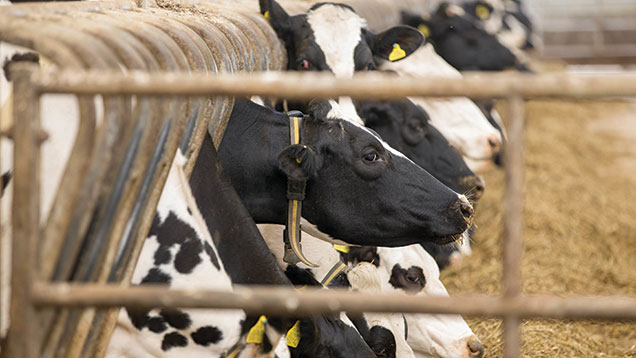How to design cow troughs to get the most from feed
 © Tim Scrivener
© Tim Scrivener Feed trough design and ration presentation could be holding back performance on many livestock farms, according to experts.
Mole Valley Farmers’ head of nutrition and technical service, Tom Hough, believes all producers could benefit from using cows’ signals to identify key pressure points limiting dry matter intake on farm.
“Dry matter intake is essential for cow performance and profitability, yet one of the most common issues I see are neck rubs caused by incorrectly positioned neck rails at the trough,” he said.
See also: Make heifer introduction stress free
Mr Hough says if more than 10% of the herd had neck rubs, then attention should be turned to the feed trough.
Research carried out on a Norwegian beef finishing unit has found improving neck rail position boosts growth rates by 200g/day, which suggests dairy producers could see a notable improvement in performance by doing the same.
The ultimate aim is to present cows with a palatable, consistent, well-balanced ration. This ensures the rumen works at its optimum to get the most out of the diet.
To monitor intakes and how well the ration was working, Mr Hough suggests carrying out a five-minute cow signals checklist (see below). This should include looking at the incidence of neck rubs.
See also: New Zealand dairy farmer adopts UK system
“If it’s more than 10%, the first thing you can do is push up feed more regularly so she does not have to stretch for it – 10-12 push-ups a day would be ideal, aiming for a minimum of six.”
For Holsteins, the neck rail should be 1.25m high and set 0.25m back from the trough wall, so where possible the rail should be moved to the outer side of building stanchions or attached to a bracket.
|
Five-minute benchmarking checklist for your herd |
|
|
Cow signal |
Target |
|
% of cows in cubicles lying |
90% |
|
% of cows in cubicles ruminating |
70% |
|
Number of chews per cud |
55-70 |
|
Number of breaths per minute |
20-40 |
|
Rumen fill score of lactating cow |
>3 |
|
Rumen fill score of dry cow |
>4 |
|
BCS of dry cows |
3 |
|
Change of BCS from dry cow group to cows 60d calved |
Max 0.5 BCS loss |
|
% neck rubs |
<10% |
Mr Hough says good trough set-up and plenty of space iss particularly important during the transition period to limit the natural drop in DMI around calving.
Cow body condition is also a crucial cow signal to establish how well the ration is being used.
If cows are too fat at drying off, it is too late to correct and suggests feeding is wrong in late lactation. Fat cows will also have lower intakes at calving and be more prone to metabolic problems.
“Two to three months before calving is a key time to condition score so there’s time to address problems and pull back feeding or give more. Ideally cows should be BCS 3 at drying off,” he said.
In the current milk price environment, Mr Hough says those farms feeding one ration and struggling with overfat cows at drying off or late lactation could also benefit from targeted feeding by splitting groups or feeding to yield in the parlour.
Using a Penn State separator, which sieves the ration into different components dependent on particle size, can also be a valuable tool in determining whether there was any ration sorting.
Ideally cows should receive a consistent ration through the day to promote rumen health and efficient ration use.
“Take three samples from along the feed fence, mix and put through the separator, then do the same three hours later. If they’re leaving more long fibre there could be acid loading in the rumen, which will impact on productivity and milk quality.”
